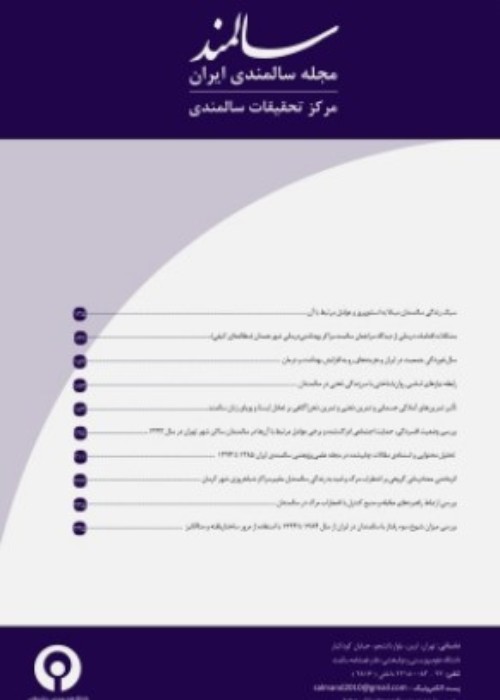Prevalence of Risk Factors for Falls Among the Elderly Receiving Care at Home
Author(s):
Article Type:
Research/Original Article (دارای رتبه معتبر)
Abstract:
Objectives
Elderly people are at the highest risk for falling. In order to design and implement effective interventions and reduce the incidence of falling and its resulting injuries, the relative importance of each risk factor should be determined. This study aimed to determine how frequently different factors contribute to falls among the elderly served by one home health agency in Tehran.
Methods & Materials
This study was a descriptive-analytic and cross-sectional study. A total of 400 elderly were selected through random cluster sampling method from all 22 districts of Tehran City, Iran. The study data were collected through a researcher-made questionnaire of falling risk factors. The questionnaire consisted of two parts: first, demographic questions and second, questions related to falling in 7 dimensions (including 60 questions). The obtained data were analyzed in SPSS (V. 19) through descriptive and inferential statistics.
Results
In this study, female samples were 52.5% of the participants (n=400) and the elderly mean±SD age was 78±8 years. The total frequency of falling among the elderly was 28% (112 out of 400). Among the elderly who had fallen (n= 112), 64 (57.1%) of them were female and their Mean±SD age was 80±7.5 years. About 82% of them fell down inside their homes, with these separate frequencies: bathroom (19.6%), toilet (18%), bedroom (18%), and hall (16%). Parts of the body which were more frequently affected by falls in forms of injuries, bone fractures, dislocations, etc., were the pelvis (26.8%), arms (22.3%) and legs (19.6%). Around 43.8% of the falling among the elderly had led to hospitalization, 44.9%, between 1 and 5 days, 36.7% between 6 and 10 days, and 18.4% between 11 and 15 days. The relationship between falls and the medical, lifestyle, or environmental risk factors was non-significant.
Conclusion
A high percentage of affected elderly were hospitalized after the incident, and among them a high percentage stayed in the hospital for a long time imposing considerable costs to the health system. Moreover, sensory and neuromuscular risk factors were the most frequent causes of falls which could be prevented by rehabilitation measures. Results showed that people who are afraid of falling have a higher risk of falling which requires adequate and special attention to this psychological risk factor.Keywords:
Falling , Risk factors , Elderly , Homecare , Iran
Language:
English
Published:
Iranian Journal of Ageing, Volume:13 Issue: 52, 2019
Pages:
638 to 650
magiran.com/p1970918
دانلود و مطالعه متن این مقاله با یکی از روشهای زیر امکان پذیر است:
اشتراک شخصی
با عضویت و پرداخت آنلاین حق اشتراک یکساله به مبلغ 1,390,000ريال میتوانید 70 عنوان مطلب دانلود کنید!
اشتراک سازمانی
به کتابخانه دانشگاه یا محل کار خود پیشنهاد کنید تا اشتراک سازمانی این پایگاه را برای دسترسی نامحدود همه کاربران به متن مطالب تهیه نمایند!
توجه!
- حق عضویت دریافتی صرف حمایت از نشریات عضو و نگهداری، تکمیل و توسعه مگیران میشود.
- پرداخت حق اشتراک و دانلود مقالات اجازه بازنشر آن در سایر رسانههای چاپی و دیجیتال را به کاربر نمیدهد.
دسترسی سراسری کاربران دانشگاه پیام نور!
اعضای هیئت علمی و دانشجویان دانشگاه پیام نور در سراسر کشور، در صورت ثبت نام با ایمیل دانشگاهی، تا پایان فروردین ماه 1403 به مقالات سایت دسترسی خواهند داشت!
In order to view content subscription is required
Personal subscription
Subscribe magiran.com for 70 € euros via PayPal and download 70 articles during a year.
Organization subscription
Please contact us to subscribe your university or library for unlimited access!


